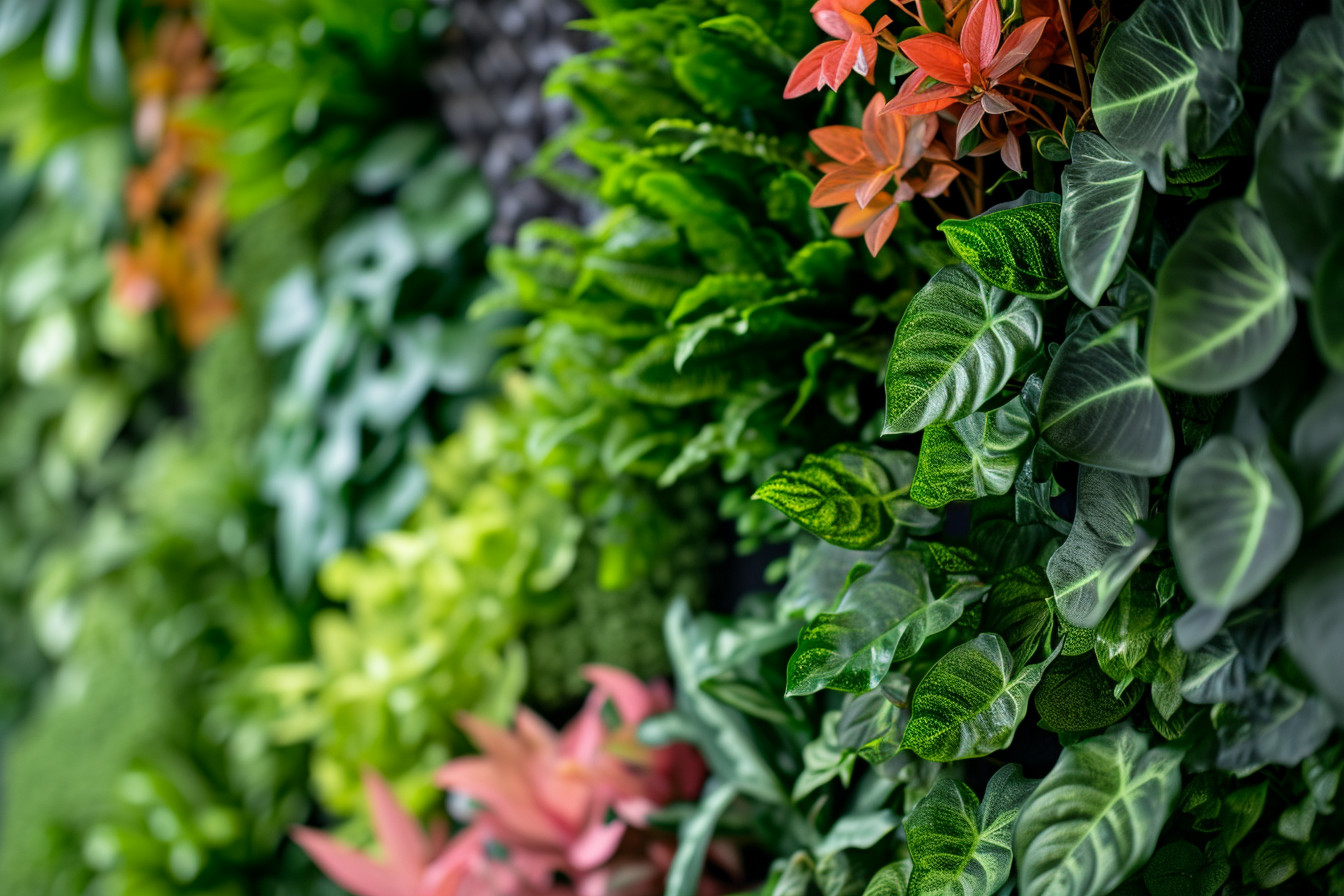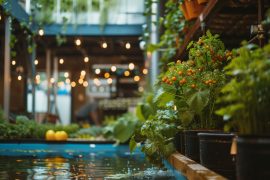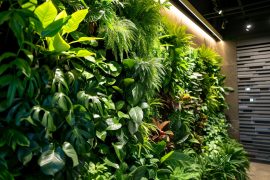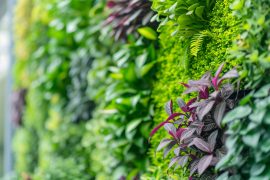Ever strolled through a lush indoor garden and thought, “I wish I could do this at my place”? Well, I’ve been there, and let me tell you, with indoor vertical gardening, it’s not just a dream. It’s the perfect mesh of nature and urban living, and I’m here to walk you through the advanced techniques that’ll turn your walls into thriving green spaces.
Choosing the Right Plants
When I first dived into indoor vertical gardening, I quickly realized that selecting the right plants wasn’t just a matter of aesthetics; it also involved understanding the intricacies of each species’ needs. Now, I’m excited to share what I’ve learned with fellow enthusiasts looking to transform their walls into lush sanctuaries.
Light Preferences Matter
Every plant has its favorite spot for basking in the sun’s glory, or shying away from it. Some plants thrive in the beaming sunlight, while others wilt if they’re kissed by too many rays. I tend to group plants by their light preferences to make sure they’re not just surviving, but flourishing. For instance, species like the snake plant or certain ferns don’t demand much light and are great for spots that are farther from windows.
Water Requirements
No one enjoys soggy feet, and plants are no different. They have varying water needs, and indoor vertical gardens need to cater to this diversity. I’ve seen plants like air plants thrive on just a misting, while herbs like basil or chives need a steady supply of moisture. The trick is to sync your watering schedule with the plants’ needs and install a drip irrigation system for hassle-free maintenance.
Growing Habits
Some might say I’ve become a bit of a plant psychologist over the years – I pay close attention to their growth habits. Plants with aggressive tendencies, like mint, need boundaries, or they’ll invade the entire wall. Others, like succulents, are more solitary and require less intervention. Recognizing these habits allows me to create a harmonious green tapestry, with each plant in its rightful place.
Weight Considerations
I’ve learned the hard way that not all walls can support a jungle. Heavier plants need a sturdy structure, so always consider the weight your vertical garden can bear. I often opt for lightweight plants like pothos or philodendrons that add a touch of the tropics without putting too much strain on the installations.
Air Quality Benefits
There’s something genuinely peaceful about being surrounded by plants. It’s not just the green that soothes the eyes but also the fresh air they gift us. I’m quite fond of adding a mix of air-purifying plants like spider plants and peace lilies to my vertical gardens. They’re like living, breathing filters that boost both the tranquility and healthiness of my indoor space.
Vertical Garden Design
When I first dived into indoor vertical gardening, I was struck by its potential for creating serenity within my home. It’s not just about cramming plants into a space; it’s about crafting an environment that resonates with peace and harmony. To achieve that, design is key.
I’ve learned that starting with a theme can help guide the selection of plants and materials. For me, it was important to reflect a natural, undisturbed woodland—each plant carefully chosen for its role in the chorus. Modern designs, however, might lean towards sleek lines and minimalistic greenery—a different kind of calm.
Placing plants is much like painting a picture. You’ve got to think about “plant layering”. Bottom dwellers, like hearty ferns, set the stage. Mid-height plants add body and texture. Then come the cascading beauties, spilling over edges to draw the eye. And let’s not forget the vibrant splashes of color from flowering species; they’re like the dabs of paint that bring the scene to life.
Lighting isn’t just functional in a vertical garden; it’s part of the design. LED grow lights, for instance, can bring the spotlight to certain plants or create a backlit effect that emphasizes the whole garden’s structure. I’ve spent evenings just tweaking light angles and it’s amazing how it can transform the space.
For those looking to replicate such designs, let’s get down to the nitty-gritty. It’s essential that you understand the technical bits. Starting with a strong framework is crucial—nobody wants a garden collapse disaster. Then there’s the matter of irrigation. It can be as simple as hand-watering each plant, but if you’re not around much, automated drip systems might be your new best friend.
Looking back at when I helped my friend set up her vertical garden, we had to figure out an irrigation system that worked for her busy lifestyle. We opted for a gravity-fed system with a timer. It was a game-changer, especially when she had to travel for work.
The fun part in this journey has always been the personal touch. Whether it’s integrating a treasured sculpture amidst the foliage or finding a way to incorporate an heirloom pot, these elements tell a story. It’s this narrative woven through the tendrils and leaves that transforms a simple garden into a personal sanctuary.
Lighting Solutions
When I set out to create a harmonious space with my indoor vertical garden, I can’t stress enough how vital lighting plays into the design. Not all spaces are blessed with abundant natural light, and that’s where artificial lighting solutions come in. They’re not just a substitute; they can be a design feature in themselves.
I’ve found that LED lights are a favorite among indoor gardeners, and for good reason. They’re efficient, have a long life span, and can provide a full spectrum of light, which is like serving up a buffet that caters to the varied tastes of different plants. Plus, LED lights emit hardly any heat, which means I can place them closer to my plants without worrying about scorching them.
Here are some lighting strategies I swear by:
- Top-Down Lighting: Ideal for tall plants at the top of my garden setup, it mimics the natural direction of sunlight.
- Under-Lighting: Got some shade-loving plants? Placing lights below can give them a soft glow without overwhelming them.
- Side Lighting: For gardens pressed against walls, side lighting ensures that my plants get light from all angles, promoting even growth.
Let’s talk about the color spectrum. Plants love blue and red lights because they contribute to leafy growth and flowering, respectively. I like to play around with a mix of both; it not only benefits my plants but also creates a serene, otherworldly vibe in my space.
When it comes to implementing these lighting solutions, I’ve learned that it’s not just about placement but also about timing. Plants need a rest too, so I set up my lights on timers, typically for 12 to 16 hours per day, depending on the plants’ needs. It mimics the natural day-night cycle, and hey, it’s energy-saving!
I have to mention smart garden tech. Imagine being able to control the intensity and duration of light through your smartphone. These systems are perfect for gardeners who love a bit of tech and convenience. I’m all for anything that makes tending to my indoor greenery less of a chore and more of a joy.
Watering and Irrigation Systems
I’ve found that one of the most peaceful aspects of indoor gardening is the act of watering—there’s something almost meditative about nourishing the plants, watching the water trickle down, and imagining it as the very lifeblood of the garden. But as picturesque as it may be, hand-watering can become quite the chore, especially with taller or larger vertical setups. That’s where advanced watering and irrigation systems swoop in to save the day, and your back.
In the world of vertical gardens, efficient water usage is not just convenient, it’s essential. Techniques like drip irrigation or self-watering planters are both incredibly effective and speak to the very heart of sustainable gardening. Drip systems, for instance, provide water directly to the roots of the plants, reducing waste significantly. Often, I get questions about the complexity of setting these up, but trust me, it’s simpler than it looks. Plus, the joy of seeing your plants thrive without daily hand-watering—priceless.
Let me walk you through a basic drip system setup that I use which involves a central reservoir, a pump, and a timer. The pump sends water through small tubes that release it drop by drop. Now, I know you might be wondering about the technicalities, but here’s the scoop:
- Set up the reservoir at the base of your garden.
- Attach the pump and connect the tubing.
- Run the tubing up the vertical structure, with smaller feeder tubes going to each plant.
- Set your timer to water at regular intervals.
This system reuses water as it drains from the top plants to the ones below, which not only conserves water but also keeps nutrient distribution pretty even.
To get a bit more high-tech, I’ve experimented with hydroponic systems integrated into my vertical garden. In these setups, the roots of the plants are suspended in water, soaking up a nutrient solution. There’s no soil involved, which minimizes mess and pests. I find this method particularly fascinating because it illustrates the strong connection between human innovation and the essence of nature’s growth processes.
Self-watering planters are another boon for us indoor gardeners. These planters have a built-in reservoir, and they use the principle of capillary action to provide water to the soil and roots as needed. It’s pretty impressive to watch – a seamless, almost invisible process that ensures my plants get just what they need.
Maintenance and Care Tips
As I tend to my vertical oasis, I’ve learned that consistent maintenance is key to a lush and thriving garden. It’s like tuning an instrument – every little adjustment can lead to perfect harmony.
Standing amid my leafy friends, watering can in hand, the contemplative quietness envelops me. I’m reminded that indoor gardens are not just about the harvest but also about nurturing a slice of nature’s peace within four walls. Still, there’s practical work to be done to keep these gardens in tip-top shape.
Regular Pruning and Deadheading: This isn’t just about aesthetics; it’s about the plant’s health. By trimming back overzealous leaves and dying flowers, more energy is directed towards growth and fruit production. Here’s a soothing routine I follow:
- Check each plant for yellowing or dead leaves
- Snip them at the base with clean, sharp scissors
- Gently remove wilted flowers to encourage new blooms
Pruning this way becomes a meditative practice. It’s me and my plants, growing together, getting stronger.
Pest Control: It’s easy to overlook, but indoor gardens can experience pest invasions too. I prefer non-toxic treatments because they maintain my garden’s harmony. In case of an infestation, neem oil has been my go-to solution – it’s effective and safe for my plants and me.
Monitoring Growth: Observing your garden’s growth patterns can be surprisingly fascinating. It tells a story of resilience and life. I keep tabs on how the plants are doing and adjust my care routine accordingly. If I see a plant struggling, I’ll look into whether it requires more light, less water, or perhaps a different nutrient mix.
Being educational, I should mention that lights can make a significant difference. The right LED grow lights can boost your plants’ growth exponentially, especially in a vertical setup where natural light is a precious commodity.
Moreover, the narrative of a perfect indoor garden must include the right balance of nutrients. It isn’t as straightforward as just watering your plants – they need a concoction of nutrients and minerals to truly flourish. Typically, a balanced, water-soluble fertilizer does the trick. I apply it every couple of weeks, but it’s important to follow the guidelines specific to your garden’s needs.
Fonal Thought
So there you have it! Keeping your indoor vertical garden in top shape is all about the details. Remember, a little effort goes a long way in ensuring your green space flourishes. Stay on top of pruning and keep an eye out for pesky intruders. Trust me, your plants will thank you with lush growth and bountiful yields. And don’t forget, tweaking your routines as your garden evolves is part of the fun. Happy gardening, folks!








